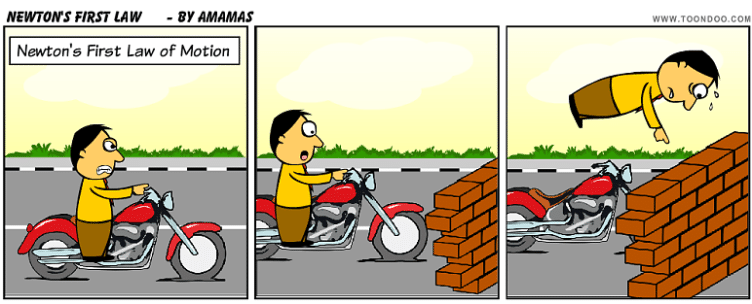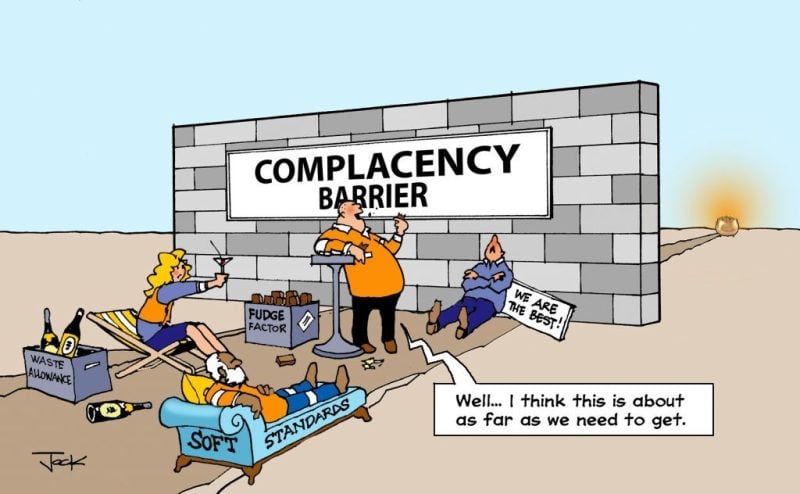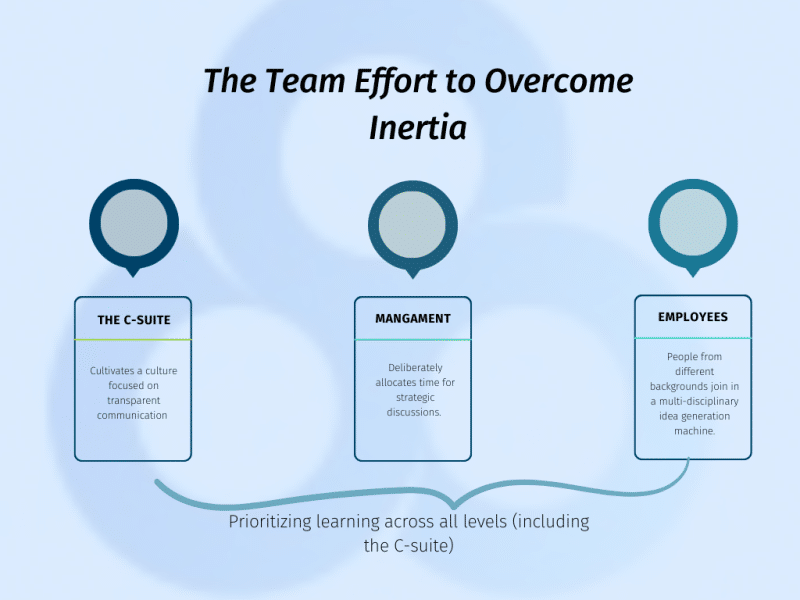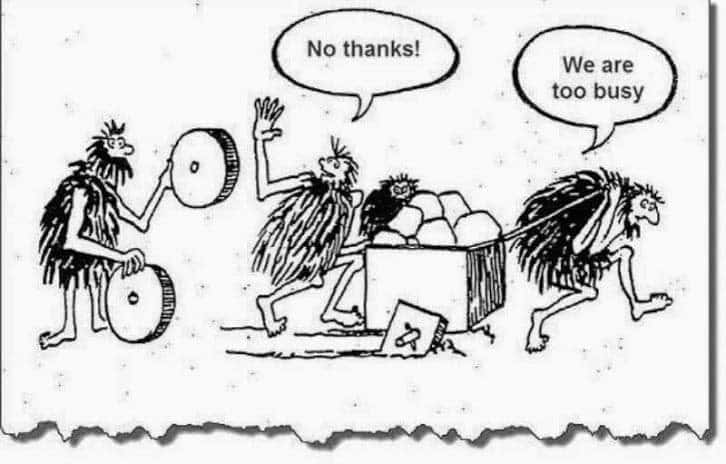On the night of December 25-26, 1776, General George Washington led a surprise attack against Hessian soldiers (mercenaries fighting for the British) stationed in Trenton, New Jersey.
The Hessian forces were either sleeping or celebrating Christmas, oblivious to a possible attack on a Holy night.
Their complacency allowed Washington’s forces to cross the Delaware River, launch a successful surprise assault, and capture nearly 1,000 Hessian soldiers and their supplies.
This victory was pivotal for the US’s success in its quest for independence from the British Empire.
This battle is often cited as an example of a successful military maneuver that took advantage of the enemy’s complacency or lack of preparedness.
Mirroring the unsuspecting turn of events at Trenton, organizational inertia is a formidable adversary for modern enterprises.
Just as Washington used surprise tactics, organizational inertia occurs when entrenched routines, habits, and mindsets block your company’s ability to adapt and progress.
However, ours isn’t a battle of physical power and firearms.
Instead, it’s a battle of mindset, resilience, and innovation.
Today’s article examines organizational inertia and how it can become a company’s doom.
We’ll dive deeper into the concept, analyzing its reasons and giving you the gameplay to overcome organizational inertia and its consequences.
Understanding Organizational Complacency and Inertia
Organizational inertia has been studied since 1990 when Singh and Lumsden borrowed the word “inertia” from physics to discuss how organizations can get stuck in stagnant processes and refuse to change their ways.
This can mean the company doesn’t change its products, processes, rules, and values.
In a nutshell, inertia (or organizational complacency) appears when the company keeps doing things the old way, like a habit and resists doing things differently.

Organizational complacency has many faces, being described in various ways. However, for the sake of brevity, let’s discuss the most common manifestations of inertia encountered inside organizations.
Insights Intertia
Insight inertia occurs when a company doesn’t understand the industry in which it operates.
In this case, either management or the C-Suite needs help understanding internal and external trends and insights, causing innovation stagnation inside the organization.
When insight inertia occurs, decision-makers inside the organization don’t have the correct information to make better decisions and move the company forward.
Consequently, these companies will soon be overrun by their more agile competitors without adapting to market dynamics.
Psychological Inertia
Unlike insight inertia, which is knowledge-led, psychological inertia happens because of the people inside the company and their own biases.
People showcase a natural resistance to change because they’re worried about losing the status quo.
Psychologically speaking, change can be complicated and scary, so decision-makers prefer to stick to what they know, getting stuck in their comfort zones.
Action Inertia
Another part of organizational inertia is action inertia.
This happens when a company takes too much time to get things in motion and implement new ideas, processes, or tech solutions.
Action inertia leads to resource rigidity, where valuable assets remain unused, as well as an over-reliance on the decision-making process.
Results follow action, but without action, the decisions are useless.
Structural Inertia
An exciting study by S. Haag discusses how some companies are too set up on how to do things, refusing to change.
These companies will stick to their old ways even if they could be better, worrying about the costs and resources involved in structural changes.
Rigid managers perceive this type of inertia as a virtue, sticking to what worked before instead of what the market reality demands.
However, in the long term, refusing to change end up costing companies more in terms of missed opportunities and the lack of agility pushing customers away.
elementor-template id=”19741″
The Impact of Complacency on Organizational Growth
While we all have a general idea about inertia and how it becomes a competitive disadvantage in such a fast-paced environment, the consequences of complacency go even further than imagined.
You can almost smell the threat of notions such as “preserving the status quo,” “relying on past success,” “avoiding disruptions,” or the famous “It’s how we’ve always done it” and how these words block idea implementation and the overall growth of a company.
If you’re still somewhat enamored with the strategies, processes, and structures that brought you this far, you should understand the consequences of inertia taking root within an organization.
- Weak Competitiveness
Your competitive edge declines as innovative thinking and adaptability stagnate.
Your competitors forge ahead with fresh ideas and approaches while your organization still acts as if it’s 2019. That’s a recipe for disaster, as customers are drawn to innovative solutions.
Without a commitment to staying ahead, your business risks becoming obsolete.
- Acceptance of Mediocrity
Subpar, “good enough” performance becomes the norm.
If the pursuit of excellence and creative idea generation takes a back seat, you’ll witness a decrease in product quality, customer service, and overall operational efficiency.
In time, low standards lead to a lack of motivation to exceed expectations and deliver exceptional value to customers.
- More Power to Competitors
As your organization remains in a stagnant growth stage, competitors gain momentum, capturing market share.
They identify and capitalize on market trends, customer preferences, and emerging technologies, gradually gaining momentum and expanding their market presence.
By the time your organization overcomes inertia, competitors may have secured a substantial market share, making it challenging to regain lost ground.
- Talent Drain
High-performing individuals become disengaged when their disruptive ideas go unnoticed, or their creativity isn’t leveraged.

Performers seek challenges, growth opportunities, and a dynamic work environment.
If their potential goes untapped, they may become disengaged or seek more stimulating opportunities elsewhere.
They’re abandoning the ship, so to speak, seeking a new workplace that encourages innovation and provides a platform for personal and professional development.
- Loss of Customers
Consumers are drawn to companies that consistently deliver value, evolve with their needs, and provide exceptional experiences.
Complacency jeopardizes these crucial aspects.
As loyalty disappears, your customers, revenue, and the business itself may eventually be lost.
Mediocre processes, customers fleeing, talented employees quitting – the CEO’s greatest nightmare.
And yet, like most unfortunate situations, somehow you wake up too late to change anything; when the damage is already done.
To avoid this scenario, let’s analyze the signs of organizational inertia to determine when to intervene and set up change management processes.
Breaking the Chains of Complacency: Identifying the Signs
No one advocates mindlessly replacing tried and tested processes when breaking organizational barriers. Blending tradition and progress is a fine art that can propel your organization on its quest for success.
However, there comes a time when you need to revamp your organization – or get left behind.
Be mindful of the following actions and mindsets revealing your organization might be a victim of inertia.
Prioritizing Short-Term Gains Over Long-Term Progress
Organizational inertia is revealed by a tendency within an organization to focus on immediate outcomes that generate quick wins or profits, often at the expense of long-term development.
Over time, this short-sighted strategy can hurt your organization’s ability to adapt to changing market dynamics and technological advancements.
Opportunities Missed due to Slow Decision-Making
If your organization hesitates or takes an extended period to make critical decisions, it risks missing out on exciting opportunities.
This could be due to bureaucracy, a lack of streamlined decision-making processes, or a culture of overcaution.
Inability to Adapt to Client Needs
Customers expect quick responses and out-of-the-box solutions to their problems.
Unfortunately, inertia-led companies struggle to anticipate, sense, and promptly address consumers’ needs. In the long run, these companies will undoubtedly suffer from customer dissatisfaction and loss of business.
Challenges to Cultivate an Innovation-Led Culture
Fostering innovation inside the company is the crucial element of staying competitive.
When complacency blocks idea-sharing and creative problem-solving, you’re left with stagnant products, services, or processes. This situation leaves you vulnerable to disruptions from more innovative competitors.

Risk-Averse and Conservative Culture
A conservative culture that shies away from risks and resists embracing change is a culture that never adapts and evolves.
The world was built on evolution and innovation, and companies simply can’t survive without the two.
Embracing calculated risks is essential for your agility as a company.
Yet, not all hope is lost, as many companies before faced inertia, fought it, and came out of it stronger than ever.
Netflix and its evolution from an online recommendation site to a streaming giant is one example that comes to mind.
Let’s move on to a more action-based mindset and discover who and how can fight and defeat inertia inside your company.
Unleashing the Power of Innovation
Two things must happen for a company to embrace change and escape its old ways.
The first is understanding that meaningful change takes time.
The second is teamwork.
While the CEO must steer the ship, every one of his teams must contribute to overcoming resistance to change.
The CEO Must Cultivate Transparent Communication Culture
The CEO plays a pivotal role in shaping the organization’s communication dynamics.
Transformative leadership means intentionally fostering a transparent communication and open dialogue culture where people’s opinions (even critiques) are heard.
Employees feel empowered to share their thoughts, concerns, and ideas in this environment.
Leadership Teams Must Strategize and Reserve Discussion Time
Effective leadership involves deliberately allocating time for strategic discussions and actionable tactics.
Top management must ensure that all decisions are well-informed, aligned with the company’s goals, and responsive to changing circumstances.
Through thoughtful and purposeful discussions, the leadership team improves their collective decision-making capabilities, which is crucial for steering the organization successfully through transitions.
Engaging Employees through Shared Vision
Discussions about the company’s shared vision impart a sense of purpose and allow them to understand how their roles contribute to the collective goals.
Fostering employee engagement will open the door to action, as people from different backgrounds join together in a multi-disciplinary idea generation machine.
Moreover, transparent communication about the company’s direction fosters a sense of unity and commitment, empowering employees to give their all and align their efforts with the larger organizational strategy.
Prioritizing Learning Across Levels (including the C-suite)
Innovation is the natural consequence of a commitment to continuous learning and development.
However, sometimes managers demand this commitment from their teams without adhering to it themselves.
Driving organizational progress means focusing on learning.
Starting from the C-suite, leaders set the stage for improved problem-solving, innovative thinking, and effective response to changing market dynamics.

While it’s not a one-person battle, the C-suite must set the tone for the change and lead by example to instill the winds of change in their teams.
But what happens when the teams are scared or reluctant to change?
Challenging the Status Quo: Overcoming Resistance
Navigating change and growth can be challenging in itself for individuals.
If employees resist organizational change, still holding onto the old course, you can take a series of steps to help them entertain, then accept the idea.
- Listen Up and Engage
First, when someone’s not on board with organizational change, pay attention to them.
Engage them in a conversation. Find out what’s bothering them.
Sometimes, just allowing people to share their concerns works wonders. It shows that the company cares about its people and values their input.
- Explain Why
When you try and bring someone to a new restaurant, you start by explaining why it’s great.
The same goes for changes at work.
People are likelier to jump on board if they know why the change is happening. It’s like saying,
“Hey, we’re doing this because it will improve things.”
- Get Everyone Involved
Remember, it’s not just about the higher-ups making decisions.
Get the people who actually do the work involved. Ask them what they think, what’s working, and what’s not.
It’s like building a puzzle together – everyone’s got a piece to contribute.
- Find Change Champions
Pick influential team members from different company parts who are open to hearing you out – and get other people to hear you. These are your change champions, a.k.a. ambassadors for change.
Your change agent can help spread the word and make the whole process feel less daunting.
Remember that resistance to change is natural, and you should have patience with your employees. At the same time, be mindful of lost causes and be wary of getting stuck because of them.
Sometimes people are too set in their ways to understand your initiatives – and that’s ok.

We say out with the old, in with the new, as we move on to another exciting part of our journey.
Embracing a Culture of Continuous Improvement and Innovation
Change management strategies play a crucial role in overcoming resistance to change.
These strategies involve identifying and tackling the sources of resistance, ranging from employee pushback to the fear of stepping into the unknown or even structural obstacles.
Effective change management encompasses several key components, including:
- creating a shared vision
- involving stakeholders
- providing essential resources and support to facilitate the process of change
What’s remarkable is that change management can be implemented at any stage of an organization’s journey, regardless of its lifecycle phase.
In fact, mature organizations grappling with the implications of change face distinct obstacles owing to their well-established structures, deeply ingrained processes, and long-standing cultural norms.
Change management and a culture of continuous improvement and innovation go hand in hand.
While change management offers a structured framework to guide transformation, innovation-led culture becomes the fertile ground for change.
Blend the two, and you’ll empower your business to navigate change, overcome resistance, and pave the way for a future steeped in progress, evolution, and limitless potential.
Questioning Existing Processes: The Art of Critical Thinking
We already established that change is the norm and innovation drives progress.
In this context, you’ll find a fundamental skill that holds the potential to shape the course of organizations – critical thinking.
At the heart of this lies the ability to question the familiar, challenge existing processes, and embrace a mindset beyond the ordinary.
Critical thinking in business empowers leaders to thoroughly consider the pros and cons and determine the optimal path forward, making decisions that align with the organization’s objectives and drive progress.
In this process, identifying and resolving challenges become fundamental. Fortunately, by applying critical thinking to problem-solving, leaders adapt and resolve problems quicker, contributing to a more agile and resilient organization.
Critical thinking also lies at the core of innovation, the driving force behind any successful organization.
Questioning assumptions, challenging established norms, and thinking creatively is how you inspire your teams to generate mindblowing concepts and adapt to changing trends in the industry.
Moreover, by acknowledging and challenging your biases, you can make objective decisions less influenced by personal preferences or preconceived notions.
In short, critical thinking is an essential skill you’ll need to battle inertia. It’s your ability to ask “why” and then reach an objective, unbiased answer.
And the answer?
The answer is your way out of complacency.
But how do you know what “out” means?
Measuring and Evaluating Innovation Success
Operating inside a Big Data zeitgeist means you can measure almost anything.
Performance indicators are set in stone for all processes – from acquisition to retention and even customer loyalisation.
In this context, are there any innovation metrics you can use to evaluate your progress in overcoming inertia?
While there’s no specific formula for the ROI of innovation, measuring success is possible when you apply the Innovation Culture Score (ICS).
The ICS is a numerical depiction that reflects an organization’s innovation culture. It considers various factors linked to innovation culture to gauge how well the organization nurtures an environment that promotes innovation.
The process of measuring innovation impact through the ICS involves a sequence of well-defined steps:
- Identify and Define Relevant Components
The first step is to pinpoint the specific aspects of innovation culture that hold relevance to the organization.
It requires a thoughtful analysis of your organization’s goals, values, and industry dynamics and can include factors such as openness to new ideas, risk tolerance, collaboration, and employee empowerment.
- Develop an Assessment Tool
Once the components are identified and defined, you should create a tailored survey or assessment tool.
This tool gathers feedback from various stakeholders, including employees at all levels, leaders, and possibly even customers.
You should carefully craft the questions within the survey to reflect the chosen components and generate meaningful responses.
- Administer the Survey and Collect Data
The survey is distributed to the target respondents, and data is collected regarding their perceptions and experiences related to the identified components of innovation culture.
- Analyze Data and Assign Weights (Importance)
Once you collect the survey responses, the next step involves analyzing the data to understand each component’s strengths and areas of improvement.
Based on the organization’s priorities, you must assign weights (importance) to each component to reflect their relative importance.
- Calculate Average Scores
With the weights assigned, you have to calculate the average score for each component.
This step involves summing up the individual responses and dividing by the total number of responses.
The resulting average scores provide a quantitative representation of how the organization is perceived in each component.
In simpler terms, the ICS is determined by multiplying the average score of each component by its respective weight and then summing up these weighted scores across all segments.
In the lack of other innovation success metrics, it’s through the ICS that you evaluate your organizational transformation. With it, you can understand the effectiveness of your efforts to promote innovation and overcome inertia once and for all.
Wrap Up
Don’t be fooled.
Organizational change and overcoming inertia aren’t a walk in the park.
We’re talking about an uphill battle, demanding determination, resilience, and a commitment to breaking down barriers and embracing transformation.
However, it’s a necessary battle, as inertia and complacency will cost you customers, employees, and even your business.
And yet, you won’t have to fight the battle alone. It will be a collective effort uniting individuals, teams, and leaders.
Together, you can turn inertia into innovation, challenges into success, and stillness into growth.
Good luck!
Frequently Asked Questions about Organizational Inertia
What is organizational complacency, and how does it hinder growth?
Organizational complacency is a state where an organization becomes content with its current achievements and resists making necessary changes or improvements.
It hinders growth by stifling innovation, limiting adaptability, and preventing the exploration of new opportunities.
Complacency leads to a stagnant environment where employees and processes remain unchanged, hindering the organization’s ability to evolve and thrive.
How can complacency affect an organization’s ability to innovate?
When complacency takes root, employees may become resistant to trying new ideas or challenging the status quo. This reluctance to explore new possibilities stifles creativity and prevents the development of fresh solutions.
As a result, the organization misses out on potential breakthroughs and falls behind more agile and innovative competitors.
What are the signs of organizational complacency, and how can they be identified?
Signs of organizational complacency include a lack of enthusiasm for change, a resistance to adopting new technologies or processes, a disregard for customer feedback, and a focus on maintaining the status quo rather than seeking improvement.
These signs can be identified through employee surveys, low levels of engagement, declining customer satisfaction, and a lack of new initiatives or projects.
Additionally, a decline in overall performance or market share can also indicate complacency.
How can leaders overcome resistance to change and inspire employees to embrace innovation?
Leaders can overcome resistance to change and inspire innovation by fostering a culture of openness, continuous learning, and experimentation. Effective communication is key, as leaders should clearly explain the reasons behind changes and the benefits they bring.
Involving employees in decision-making and encouraging their input can empower them to feel invested in the change process. Recognizing and rewarding innovative ideas also motivates employees to actively contribute.
Additionally, providing training and resources for skill development equips employees to adapt and embrace new ways of thinking.
By setting an example through their own willingness to embrace change, leaders can inspire employees to see innovation as an exciting opportunity rather than a daunting challenge.